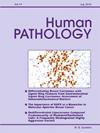Genetic landscapes of breast tumors by next-generation sequencing with focus on less common types and genotype-phenotype correlations
IF 2.6
2区 医学
Q2 PATHOLOGY
引用次数: 0
Abstract
Next-generation sequencing (NGS) has transformed our understanding of oncogenic pathways and mutational processes underlying many breast tumors. Although large-scale NGS studies included mostly common invasive breast carcinomas, the genetic landscapes of several less common or rare special histologic types and other breast tumors have now also been elucidated. Many of these lesions harbor highly specific types of mutations or rearrangements/gene fusions, including invasive lobular carcinoma, tall cell carcinoma with reversed polarity, most salivary gland-like neoplasms, fibroepithelial neoplasms, and mesenchymal tumors such as fibromatosis, nodular fasciitis, and dermatofibrosarcoma protuberans. In some cases, surrogate immunohistochemical or RNA in situ hybridization markers evaluable by light microscopy have been shown to correlate with the underlying genetic alterations. Angiosarcomas and other special breast cancer subtypes, such as triple negative apocrine carcinomas, metaplastic carcinomas, and a subset of ER-positive carcinomas (mucinous and micropapillary carcinomas, neuroendocrine neoplasms) have not been associated with specific genetic underpinnings but are enriched for certain genetic features and oncogenic pathways. The identification of characteristic genetic alterations or their molecular surrogates can be useful to establish an accurate diagnosis, and in some cases, may point to potentially actionable therapeutic targets. This review aims to summarize the genetic landscapes of less common benign and malignant breast tumors, with special attention to genotype-phenotype correlations and to the diagnostic utility of genetics and surrogate markers when applicable. BRCA1/2-associated breast carcinomas will also be discussed due to the association of so-called BRCAness with basal-like histology.
通过下一代测序研究乳腺肿瘤的遗传景观,重点关注不常见类型和基因型-表型相关性。
下一代测序(NGS)已经改变了我们对许多乳腺肿瘤的致癌途径和突变过程的理解。尽管大规模的NGS研究主要包括常见的浸润性乳腺癌,但一些不太常见或罕见的特殊组织学类型和其他乳腺肿瘤的遗传景观现在也得到了阐明。许多此类病变包含高度特定类型的突变或重排/基因融合,包括侵袭性小叶癌、极性相反的高细胞癌、大多数唾液腺样肿瘤、纤维上皮肿瘤和间充质肿瘤,如纤维瘤病、结节性筋膜炎和皮肤纤维肉瘤。在某些情况下,可通过光学显微镜评估的替代免疫组织化学或RNA原位杂交标记已被证明与潜在的遗传改变相关。血管肉瘤和其他特殊的乳腺癌亚型,如三阴性大汗腺癌、化生癌和一部分er阳性癌(粘液和微乳头状癌、神经内分泌肿瘤)与特定的遗传基础无关,但与某些遗传特征和致癌途径有关。鉴定特征性的遗传改变或其分子替代物有助于建立准确的诊断,在某些情况下,可能指出潜在的可操作的治疗靶点。本综述旨在总结不常见的良性和恶性乳腺肿瘤的遗传景观,特别关注基因型-表型相关性以及遗传学和替代标记在适用时的诊断效用。brca1 /2相关乳腺癌也将被讨论,因为所谓的brca1 /2与基底样组织学相关。
本文章由计算机程序翻译,如有差异,请以英文原文为准。
求助全文
约1分钟内获得全文
求助全文
来源期刊

Human pathology
医学-病理学
CiteScore
5.30
自引率
6.10%
发文量
206
审稿时长
21 days
期刊介绍:
Human Pathology is designed to bring information of clinicopathologic significance to human disease to the laboratory and clinical physician. It presents information drawn from morphologic and clinical laboratory studies with direct relevance to the understanding of human diseases. Papers published concern morphologic and clinicopathologic observations, reviews of diseases, analyses of problems in pathology, significant collections of case material and advances in concepts or techniques of value in the analysis and diagnosis of disease. Theoretical and experimental pathology and molecular biology pertinent to human disease are included. This critical journal is well illustrated with exceptional reproductions of photomicrographs and microscopic anatomy.
 求助内容:
求助内容: 应助结果提醒方式:
应助结果提醒方式:


